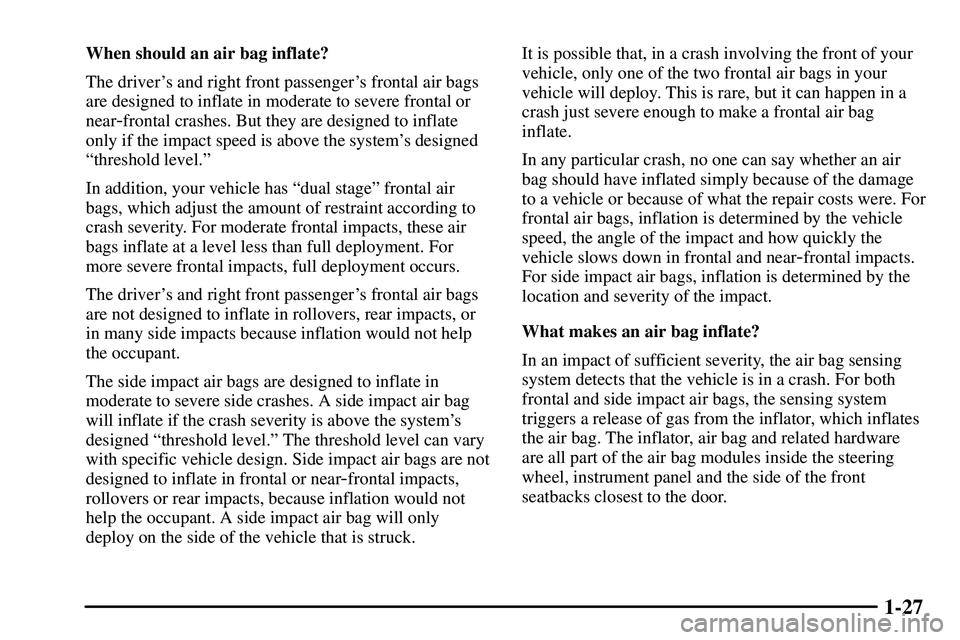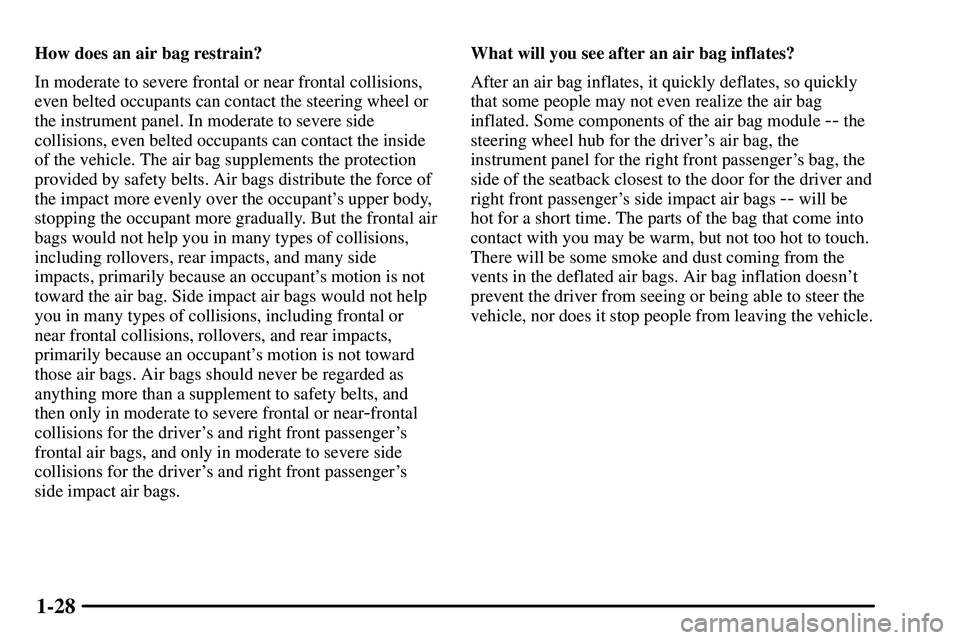Page 16 of 381
1-10
In most states and in all Canadian provinces, the law
says to wear safety belts. Here's why: They work.
You never know if you'll be in a crash. If you do have a
crash, you don't know if it will be a bad one.
A few crashes are mild, and some crashes can be so
serious that even buckled up a person wouldn't survive.
But most crashes are in between. In many of them,
people who buckle up can survive and sometimes walk
away. Without belts they could have been badly hurt
or killed.
After more than 30 years of safety belts in vehicles,
the facts are clear. In most crashes buckling up does
matter ... a lot!Why Safety Belts Work
When you ride in or on anything, you go as fast as
it goes.
Take the simplest vehicle. Suppose it's just a seat
on wheels.
Page 31 of 381
1-25 How the Air Bag Systems Work
Where are the air bags?
The driver's frontal air bag is in the middle of the
steering wheel.
The right front passenger's frontal air bag is in the
instrument panel on the passenger's side.
The driver's side impact air bag is in the side of the
driver's seatback closest to the door.
Page 32 of 381
1-26
The right front passenger's side impact air bag is in the
side of the passenger's seatback closest to the door.
CAUTION:
If something is between an occupant and an air
bag, the bag might not inflate properly or it
might force the object into that person causing
severe injury or even death. The path of an
inflating air bag must be kept clear. Don't put
anything between an occupant and an air bag,
and don't attach or put anything on the steering
wheel hub or on or near any other air bag
covering. Don't let seat covers block the inflation
path of a side impact air bag.
Page 33 of 381

1-27
When should an air bag inflate?
The driver's and right front passenger's frontal air bags
are designed to inflate in moderate to severe frontal or
near
-frontal crashes. But they are designed to inflate
only if the impact speed is above the system's designed
ªthreshold level.º
In addition, your vehicle has ªdual stageº frontal air
bags, which adjust the amount of restraint according to
crash severity. For moderate frontal impacts, these air
bags inflate at a level less than full deployment. For
more severe frontal impacts, full deployment occurs.
The driver's and right front passenger's frontal air bags
are not designed to inflate in rollovers, rear impacts, or
in many side impacts because inflation would not help
the occupant.
The side impact air bags are designed to inflate in
moderate to severe side crashes. A side impact air bag
will inflate if the crash severity is above the system's
designed ªthreshold level.º The threshold level can vary
with specific vehicle design. Side impact air bags are not
designed to inflate in frontal or near
-frontal impacts,
rollovers or rear impacts, because inflation would not
help the occupant. A side impact air bag will only
deploy on the side of the vehicle that is struck.It is possible that, in a crash involving the front of your
vehicle, only one of the two frontal air bags in your
vehicle will deploy. This is rare, but it can happen in a
crash just severe enough to make a frontal air bag
inflate.
In any particular crash, no one can say whether an air
bag should have inflated simply because of the damage
to a vehicle or because of what the repair costs were. For
frontal air bags, inflation is determined by the vehicle
speed, the angle of the impact and how quickly the
vehicle slows down in frontal and near
-frontal impacts.
For side impact air bags, inflation is determined by the
location and severity of the impact.
What makes an air bag inflate?
In an impact of sufficient severity, the air bag sensing
system detects that the vehicle is in a crash. For both
frontal and side impact air bags, the sensing system
triggers a release of gas from the inflator, which inflates
the air bag. The inflator, air bag and related hardware
are all part of the air bag modules inside the steering
wheel, instrument panel and the side of the front
seatbacks closest to the door.
Page 34 of 381

1-28
How does an air bag restrain?
In moderate to severe frontal or near frontal collisions,
even belted occupants can contact the steering wheel or
the instrument panel. In moderate to severe side
collisions, even belted occupants can contact the inside
of the vehicle. The air bag supplements the protection
provided by safety belts. Air bags distribute the force of
the impact more evenly over the occupant's upper body,
stopping the occupant more gradually. But the frontal air
bags would not help you in many types of collisions,
including rollovers, rear impacts, and many side
impacts, primarily because an occupant's motion is not
toward the air bag. Side impact air bags would not help
you in many types of collisions, including frontal or
near frontal collisions, rollovers, and rear impacts,
primarily because an occupant's motion is not toward
those air bags. Air bags should never be regarded as
anything more than a supplement to safety belts, and
then only in moderate to severe frontal or near
-frontal
collisions for the driver's and right front passenger's
frontal air bags, and only in moderate to severe side
collisions for the driver's and right front passenger's
side impact air bags.What will you see after an air bag inflates?
After an air bag inflates, it quickly deflates, so quickly
that some people may not even realize the air bag
inflated. Some components of the air bag module
-- the
steering wheel hub for the driver's air bag, the
instrument panel for the right front passenger's bag, the
side of the seatback closest to the door for the driver and
right front passenger's side impact air bags
-- will be
hot for a short time. The parts of the bag that come into
contact with you may be warm, but not too hot to touch.
There will be some smoke and dust coming from the
vents in the deflated air bags. Air bag inflation doesn't
prevent the driver from seeing or being able to steer the
vehicle, nor does it stop people from leaving the vehicle.
Page 36 of 381

1-30
NOTICE:
If you damage the covering for the driver's or
the right front passenger's air bag, or the air
bag covering on the driver's and right front
passenger's seatback, the bag may not work
properly. You may have to replace the air bag
module in the steering wheel, both the air bag
module and the instrument panel for the right
front passenger's air bag, or both the air bag
module and seatback for the driver's and right
front passenger's side impact air bag. Do not
open or break the air bag coverings.
If your vehicle ever gets into a lot of water -- such as
water up to the carpeting or higher
-- or if water enters
your vehicle and soaks the carpet, the air bag controller
can be soaked and ruined. If this ever happens, and then
you start your vehicle, the damage could make the
frontal and side impact air bags inflate and safety belt
pretensioners activate, even if there's no crash. You
would have to replace the air bags, all the sensors and
related parts, parts of the safety belt system and parts of
the driver and right front passenger's seatbacks. If your
vehicle is ever in a flood, or if it's exposed to water that
soaks the carpet, you can avoid needless repair costs by
turning off the vehicle immediately and disconnecting
the battery cables. Don't let anyone start the vehicle
under any circumstances. See your dealer for service.
Page 65 of 381

2-
2-1
Section 2 Features and Controls
Here you can learn about the many standard and optional features on your vehicle, and information on starting,
shifting and braking. Also explained are the instrument panel and the warning systems that tell you if everything is
working properly
-- and what to do if you have a problem.
2
-2 Windows
2
-4 Keys
2
-6 Door Locks
2
-9 Remote Keyless Entry System (If Equipped)
2
-12 Liftgate/Liftglass
2
-14 Theft
2
-17 New Vehicle ªBreak-Inº
2
-18 Ignition Positions
2
-19 Starting Your Engine
2
-21 Engine Coolant Heater (If Equipped)
2
-22 Automatic Transaxle Operation
2
-25 Manual Transaxle Operation
2
-29 Parking Brake
2
-30 Shifting Into PARK (P)
(Automatic Transaxle Only)
2
-32 Shifting Out of PARK (P)
(Automatic Transaxle Only)
2
-33 Parking Your Vehicle
(Manual Transaxle Only)
2
-33 Parking Over Things That Burn2
-34 Engine Exhaust
2
-34 Running Your Engine While You're Parked
(Automatic Transaxle)
2
-35 Horn
2
-35 Tilt Wheel
2
-36 Turn Signal/Multifunction Lever
2
-38 Windshield Washer
2
-39 Cruise Control (Option)
2
-42 Exterior Lamps
2
-44 Interior Lamps
2
-46 Mirrors
2
-48 Storage Compartments
2
-53 Ashtrays and Cigarette Lighter
2
-53 Sun Visors
2
-57 Sunroof (Option)
2
-58 The Instrument Panel -- Your
Information System
2
-60 Instrument Panel Cluster
2
-62 Warning Lights, Gages and Indicators
2
-76 Navigation System (Option)
Page 77 of 381
2-13
To open the liftglass using your key do the following:
�To open the liftglass, insert the key into the keyhole
and turn it clockwise to the second position.�Use the handle in the center of the liftglass to help in
lifting the glass.
You can also release the
liftglass by pressing the
release button (if equipped)
located on the instrument
panel to the left of the
steering wheel.